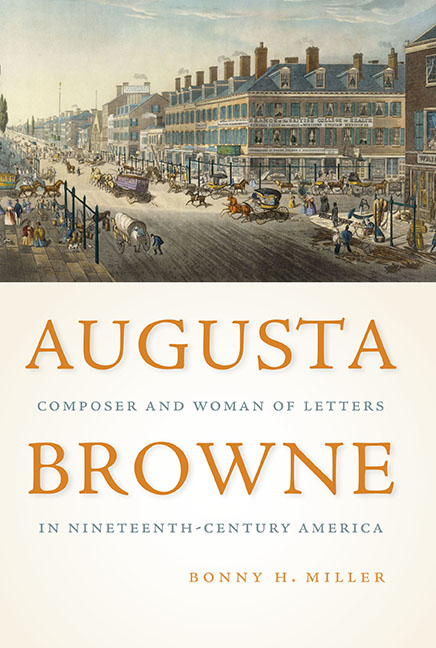Book contents
- Frontmatter
- Contents
- List of Illustrations
- Preface
- Acknowledgments
- Introduction
- 1 First Steps
- 2 Apprentice in a Family Music Business
- 3 Philadelphia Debut
- 4 A Young Professor of Music
- 5 A New Leaf
- 6 Her Own Woman
- 7 Courtship and Consequences
- 8 Pilgrim in Progress
- 9 “Glad Fruition”
- 10 Legacy in Music
- 11 Legacy in Literature
- 12 Contributions to Music Journalism
- 13 A Legacy Written into History
- Appendixes
- Appendixe 1 Children and Descendants of David Samuel Browne and Elizabeth Montgomery Browne
- Appendixe 2 Chronology of Augusta Browne’s Music and Letters
- Appendixe 3 List of Musical Works
- Appendix 4 Selected Glossary
- List of Abbreviations
- Notes
- Selected Bibliography
- Index
Appendix 4 - Selected Glossary
Published online by Cambridge University Press: 23 October 2020
- Frontmatter
- Contents
- List of Illustrations
- Preface
- Acknowledgments
- Introduction
- 1 First Steps
- 2 Apprentice in a Family Music Business
- 3 Philadelphia Debut
- 4 A Young Professor of Music
- 5 A New Leaf
- 6 Her Own Woman
- 7 Courtship and Consequences
- 8 Pilgrim in Progress
- 9 “Glad Fruition”
- 10 Legacy in Music
- 11 Legacy in Literature
- 12 Contributions to Music Journalism
- 13 A Legacy Written into History
- Appendixes
- Appendixe 1 Children and Descendants of David Samuel Browne and Elizabeth Montgomery Browne
- Appendixe 2 Chronology of Augusta Browne’s Music and Letters
- Appendixe 3 List of Musical Works
- Appendix 4 Selected Glossary
- List of Abbreviations
- Notes
- Selected Bibliography
- Index
Summary
Selected Glossary
Alberti bass a repeated keyboard figuration of broken chords, usually played by the Left hand
Augmented-sixth chord a seventh chord built on the lowered sixth degree of the scale
Bel canto literally, “beautiful singing”; describes the expressive, legato, heavily ornamented singing of baroque-era operas and early nineteenth-century Italian operas by Bellini, Rossini, and Donizetti
Brillante piano style from first half of nineteenth century, characterized by rapid, showy figuration with many scales, runs, and keyboard embroidery
Cadence harmonic point of pause or completion at the end of a piece, section, or Phrase
Cadenza improvisational section in which performer can show off impressive skill and speed
Character piece a nineteenth-century instrumental composition that explores a scene, a mood, or even an aural portrait of an individual; within this broad genre are works by Felix Mendelssohn (Lieder ohne Worte), Robert Schumann (Kinderszenen), and Frédéric Chopin (nocturnes, impromptus, ballades)
Contrafactum (plural, contrafacta) song created by adding new words to existing Music
Dominant the fifth degree of the scale or the chord built on the fifth degree, with a strong tendency to move to the tonic chord
Figured bass baroque-era keyboard notation that indicates with numbers which chord to play above a given bass line
Full cadence resting point on the tonic chord
Half cadence resting point on the dominant chord
Half-diminished chord chord built of two minor thirds plus a minor seventh
Half step interval between two adjacent notes on the keyboard, either white key to
black key, or white key to white key, if th ere is no black key between them
Homophonic musical texture that moves predominately from chord to chord
Interval distance or relationship between two pitches, whether heard one after another or sounding together
Modified strophic song form in which most verses are sung to the same musical tune, but one or two verses are altered for intentional contrast, such minor key
Modulation musical transition from one key to another
Plagal cadence cadence that moves from the subdominant chord to the tonic, often used for “Amen” at the end of hymns
Primo the treble part of a piano duo
Romance short instrumental piece of lyrical, sentimental nature, without any fixed form
- Type
- Chapter
- Information
- Augusta BrowneComposer and Woman of Letters in Nineteenth-Century America, pp. 357 - 358Publisher: Boydell & BrewerPrint publication year: 2020



